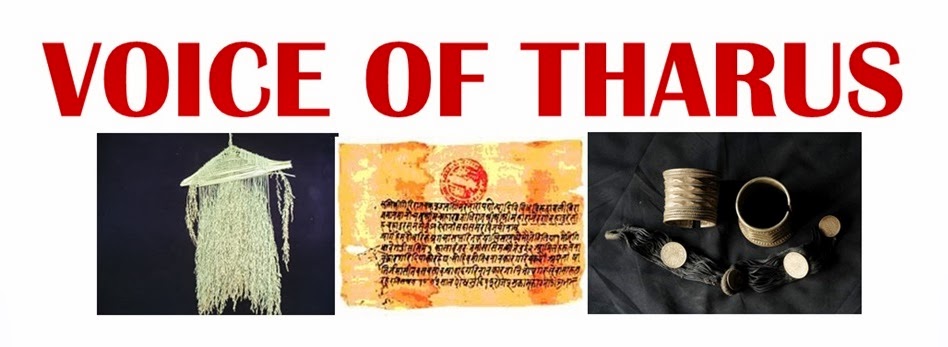 |
| Anthropologist Piers Locke driving his elephant, Sitasma Kali. Photograph by Piers Locke. Used with permission. |
Piers Locke, inspired by Mark Shand’s book Travels on My Elephant, was drawn to Nepal’s Chitwan National Park, its captive elephants and the elephant handlers for his doctoral research. A renowned social anthropologist interested in posthumanist philosophy, multispecies ethnography, and other forms of more-than-human research in the humanities and social sciences, he is not new to Nepal, Nepalis and especially Tharus.
Sanjib Chaudhary from Voice of Tharus spoke to Dr Locke about his research and his perception about the Tharu elephant handlers. Here’s an excerpt of the interview.
Voice of Tharus (VOT): How did you become interested in elephant management and particularly in Nepal?
Piers Locke (PL): After an undergraduate degree in Social Anthropology at the University of Kent I had decided I wanted to become an anthropologist. I had already visited India, and was drawn to specialise in South Asia. Consequently, I took a masters’ degree in South Asian Studies at the School of Oriental and African Studies (SOAS), University of London. It was there that I found inspiration for my doctoral research in Mark Shand’s book Travels on My Elephant. It seemed to me that the skilled practices of the mahout would make for an excellent topic of inquiry. I decided the Chitwan National Park would be an ideal location since captive elephants play a key role in park management, biodiversity conservation, and ecotourism.
VOT: How did you come across Tharu elephant handlers? Since not many Tharu elephant handlers speak English how did you manage to communicate with them?
PL: The first elephant handlers I met were at the Biodiversity Conservation Centre (BCC) in Sauraha, run by the National Trust for Nature Conservation (NTNC). I first met a Tharu mahout named Narayan, but we conversed in Nepali, which I had begun learning at SOAS. This was the language I used throughout my research. The most important person for my research was Rameshwor Chaudhary, the adhikrit subba, the chief of the government elephant section, a Tharu man with many years’ experience working with elephants. I also had the privilege of meeting Bhagu Subba, the aajivan subba, famous for saving King Mahendra’s life from a tiger attack during shikar. I made many great friends among the hattisare at Khorsor and Sauraha, most of whom were Tharus.
VOT: Can you tell our readers about your findings from the research? It would be great if you can tell something about the contribution of Tharus in the elephant handling and management in Nepal.
PL: My research was both historical and ethnographic. I was concerned with tracing the history of captive elephant management in Nepal and its changing role in trade, hunting, conservation, and tourism. I was also concerned to explore the private social world of the elephant stable, and to investigate the expert knowledge and skilled practices of the elephant handlers. I was particularly interested in apprenticeship learning, and I pursued these objectives by means of participant observation, photographic documentation, and interviewing. What became evident to me was that state sponsorship had fostered a tradition of skilled and dangerous practice by which the Tharu had become experts at capturing and caring for elephants. This tradition was still crucial for managing Nepal’s lowland national parks in the early 21st century, and yet the expertise and the effort of the Tharu hattisare was not well recognised. The historical status of the Tharu as masinya matwali (enslavable alcohol drinkers) was clearly important here, and the preponderance of Bahuns and Chetris in the DNPWC (Department of National Parks and Wildlife Conservation) was overwhelming - among this group I encountered a great deal of prejudice and ignorance regarding Tharu people, and a reluctance to acknowledge their expertise as elephant handlers.
VOT: Have you heard about King George V's hunting expedition to the Terai? Do you know any involvement of elephant handlers, particularly Tharus in facilitating the hunts?
PL: The King George V hunt is particularly well documented in photographs, and represents a topic of my current research on the historical photography of human-elephant relations in colonial South Asia. I had the pleasure of meeting Bhagu Subba, who had served on the rastriya shikar of 1959, when Queen Elizabeth II visited.
VOT: What's your general perception about Tharus? They have been complaining that they are the original inhabitants of Terai but have been pushed to the boundary and oppressed by the recent settlers from hills and southern border (India). What's your say on this?
PL: Arjun Guneratne has explored the ethnogenesis of the Tharu in his excellent book "Many Tongues, One People: The Making of Tharu Identity in Nepal”. Malarial eradication and road building programmes transformed the Tarai environment and its access from the hills in the 20th century. This has caused massive demographic and socio-economic change, which has triggered some very lively identity politics. Since the Maoist insurgency we have also seen the rise of some very fractious politicking in the form of region based political parties, which I think has tended to inflame hatred and intolerance of ethnic others. In Sauraha, I think it is unfortunate that so much touristic development has happened with only marginal participation from local Tharu. I am though very much inspired by Tharu youth who seek to empower their local communities through local development work. My friend Birendra Mahato is an excellent example - he has played a major role in the Tharu Culture Museum, in working with local NGOs, in helping stimulate artisanal economic activity (like the production of paper from elephant dung), and most recently in responding to the devastating earthquakes.
Here’s a blog post by Piers during his recent fellowship at the Rachel Carson Center for Environment and Society.
Interspecies Ethnography and Human-Elephant Relations in South Asia
Here’s an ethnographic documentary co-produced by Piers, based on his fieldwork at the Khorsor Elephant Breeding Centre.
Further, here’s a photo gallery by Piers.
